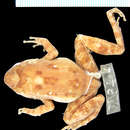Description
provided by AmphibiaWeb articles
M 32-34 mm, F 38-41 mm. A relatively large Brygoomantis from north-western Madagascar. Tibiotarsal articulation reaches the eye. Hand without webbing, foot webbing 1(0.5-0), 2i(1), 2e(0-0.5), 3i(1-2), 3e(0-1), 4i(1.5-2), 4e(1-1.5), 5(0). Terminal discs of fingers and toes slightly enlarged. Dorsal skin coarsely granular, with weakly developed dorsolateral folds. Colour dorsally brown, typically rather uniform, sometimes with a few dark markings or a light vertebral band or stripe. Venter dirty whitish with brown pigment, especially on the chest. Males with distinct femoral glands, yellowish in breeding specimens, and a weakly distensible single subgular vocal sac.Taken with permission from Glaw and Vences (2007).
Nussbaum, R. and Vences, M. (2008). Mantidactylus ulcerosus. In: IUCN 2008. 2008 IUCN Red List of Threatened Species. www.iucnredlist.org. Downloaded on 29 April 2009.
- author
- Miguel Vences
- author
- Frank Glaw
Distribution and Habitat
provided by AmphibiaWeb articles
Ambilobe, Ankarafantsika (Ampijoroa, Antsiloky, Lac Tsimaloto), Berara forest, Lokobe, Manongarivo, Nosy Be. It occurs from sea level to 1,600m asl in slow-flowing streams of rainforest, heavily degraded areas, and open swampy areas. It also inhabits agricultural land (Nussbaum and Vences 2008).
- author
- Miguel Vences
- author
- Frank Glaw
Life History, Abundance, Activity, and Special Behaviors
provided by AmphibiaWeb articles
Habits: Found along streams and in swamps. Males call from hidden positions during the day and often from more open sites on the stream border or in the stream at night. Eggs are deposited in the leaf litter or on rocks next to the water, tadpoles are flushed into the stream after hatching and develop there. Calls: A series of 4-5 pulsed notes of low intensity. Breeding takes place in slow-flowing streams (Nussbaum and Vences 2008).
- author
- Miguel Vences
- author
- Frank Glaw
Life History, Abundance, Activity, and Special Behaviors
provided by AmphibiaWeb articles
It occurs in many protected areas (Nussbaum and Vences 2008).
- author
- Miguel Vences
- author
- Frank Glaw
Mantidactylus ulcerosus: Brief Summary
provided by wikipedia EN
Mantidactylus ulcerosus is a species of frog in the family Mantellidae. It is endemic to Madagascar. Its natural habitats are subtropical or tropical moist lowland forests, subtropical or tropical moist montane forests, rivers, swamps, freshwater marshes, intermittent freshwater marshes, and heavily degraded former forest. It is threatened by habitat loss.
- license
- cc-by-sa-3.0
- copyright
- Wikipedia authors and editors

